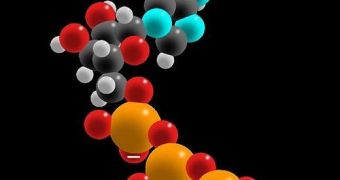Adenosine triphosphate, more commonly known as ATP, is a molecule that bears the fuel for all living things. By breaking it down, cells in all living things get the energy they need to grow and flourish. Until now, scientists have been wondering how the compound is broken down, and what reactions allow it to play such a huge role in promoting and sustaining life. This mechanism has remained obscured for many years, but now investigators at the Louisiana State University announce a major breakthrough in ATP knowledge, PhysOrg reports.
The molecule was first identified more than 80 years ago, and, as science progressed, its role in cells was determined to be crucial. In fact, many researchers now believe it to be the second most important molecule in the world, preceded only by DNA. Studies have shown that each cell contains about one billion such molecules, which allow for them to grow, transport substances, and evolve in more complex arrangements. Researchers say that ATP is also fundamental to some basic abilities, such as muscle contraction, which would otherwise be impossible. “ATP is the fuel of life. It's an energy currency molecule – the most important source of chemical and mechanical energy in living systems,” LSU Associate Professor Sunyoung Kim says.
He is the author of a new study detailing the research, which appears in the February 19 issue of the respected Journal of Biological Chemistry. The expert highlights the fact that the most difficult task biologists had to face in determining how ATP triggered its effects was discovering how proteins extracted and used the energy that was stored in this molecule. The new investigation was focused on kinesins, one of the families of proteins that are known to play a major role in breaking down ATP. In order for the energy of the three phosphate groups to be released, the third of them needs to be subjected to the influence of hydroxide, a water molecule lacking one proton. How that proton was removed has been a mystery until now.
“We picked kinesins because they're the simplest known motor proteins. Usually, proteins that break down ATP are very large and have a lot of moving parts for mechanical work. The simpler and the smaller the system is, the more likely you can capture information about it in detail,” Kim reveals. The team used an imaging technique known as X-ray crystallography to create a clear, 3D representation of the atomic structure in kinesins. The team learned that the entire chemical reaction was controlled not by an amino-acid, as first thought, but by a second water molecule, which the protein used to rip one proton of the first molecule.
“Each of these water molecules is attached to different part[s] of the protein. And, normally, they hold tightly to each other as well, keeping two very distant parts of the protein connected by a molecular bridge. Our data show, when the second water molecule takes the proton from the first one, the proton is transferred across this bridge. This causes the two different parts of the protein that the bridge holds together to unfurl, and you have motion in the protein,” Kim adds. “We believe many, if not all, proteins that use the energy from ATP breakdown may work the same way,” he concludes.

 14 DAY TRIAL //
14 DAY TRIAL //